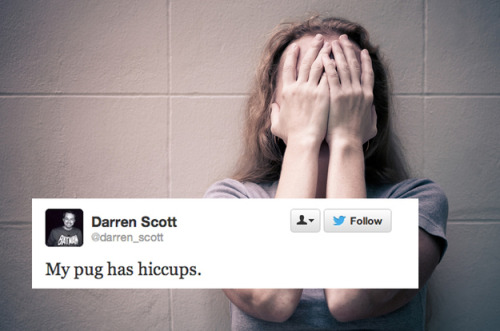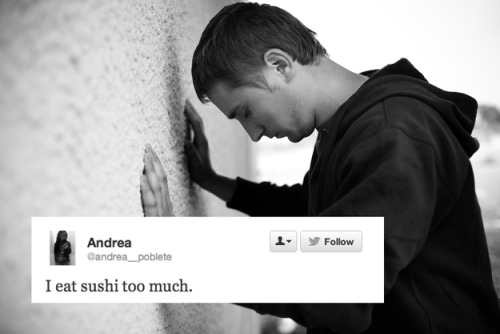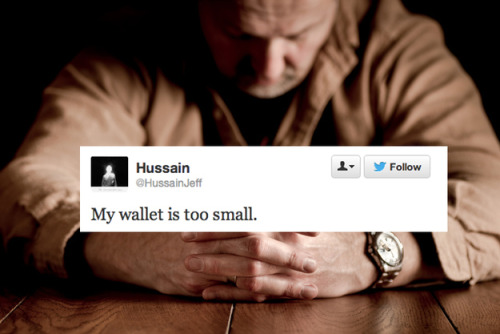Shared posts
11 Fearsome Warrior Races (That Would Be Ridiculously Easy to Defeat)

An entire species of warriors is one of the most thrilling tropes from science fiction and fantasy. Bred only for combat, with a culture based entirely on war and destruction. But sometimes that single-minded focus on slaughter can actually have its drawbacks. Here are 11 fictional warrior races that would be easy to beat.
How did crows develop a social safety net?

A lot of crows come to my backyard looking for peanuts, but this group of five was different. They were scrappy, with tattered white bits of down sticking out from between their black feathers. One of them made a cry more like a bleat than your typical caw caw! And then I discovered them doing something extraordinary.
Deadly lake lures animals to their deaths and petrifies them

Tanzania's Lake Natron is the most caustic body of water on Earth – and that makes it a terrifying, if eerily beautiful, place.
The mutant peacock that baffled London has made it home
Population, growth and decline
In a New York Times op-ed piece recently, geographer Erle C. Ellis argues “Overpopulation is Not the Problem,” dismissing fears that humanity might exceed the Earth’s carrying capacity and bring global calamity upon ourselves.
Malthusian fears swing in and out of fashion, and the pendulum can often go too far the other way, into techno-utopianism. Ellis does argue that technology allows us to increase local carrying capacity, and in fact he sees this as a deep-seated characteristic of human nature. But in his argument, technology is no panacea.
The world population is now estimated at 7.2 billion. But with current industrial technologies, the Food and Agriculture Organization of the United Nations has estimated that the more than nine billion people expected by 2050 as the population nears its peak could be supported as long as necessary investments in infrastructure and conducive trade, anti-poverty and food security policies are in place.
Keeping everyone fed, he points out, is already within our technological powers; it simply eludes our politics.
It was almost ten years ago that Phillip Longman pointed out in a SALT talk that what we actually ought to worry about is depopulation. Citing urbanization, contraception, education (especially of women), declining infant mortality, and several other factors, he explained that fertility is falling quickly and that much of the world is already reproducing below the replacement rate. This averts the Malthusian crisis many feared, but may offer other challenges to the economy.
Ultimately, it’s not fewer people that we need, but rather a better understanding of our relationships with nature and amongst ourselves in order to effect better governance and a healthier balance within the biosphere. As Ellis puts it,
The science of human sustenance is inherently a social science. Neither physics nor chemistry nor even biology is adequate to understand how it has been possible for one species to reshape both its own future and the destiny of an entire planet. This is the science of the Anthropocene.
What’s Next With the Ugly Baby?
We've been working on Ugly Baby for about twelve four years now (it started as a prototype called Musorqua right after we launched Aaaaa!), and it's now AaaaaAAaaalmost ready for prime time. A new build is on track for November 18th, so here's a sneak peek at some of what we hope to include therein:
You play the role of Azumi Pentak, blind futurist extraordinaire. She's trying to digitize the whole city of Boston Sky; and to capture the data, she's "wardiving" — BASE jumping through the city, taking measurements and scooping up every electronic signal she can. Including your brainwaves.
Azumi Pentak / Born: 8.25.2004 / Nat: American / Parents: Azumi Asahi, Gertrude Pentak / Sibs: Gabriele Pentak (dec. 4.11.2016) / Edu: BE Computer Science (2029), PhD (2025) Machine Learning, Worcester Polytechnic Institute / Foci: expert systems, neural networks / Whasian, 170cm, 53kg, pH~7.5, 1.4rgn / Prosth: ocular, inner ear / Loc: Boston Sky, Azumi@AzuCo / Incomplete: profession, physical address, biometrics.
AzumiOS Startup
Azumi was born blind, but given sight through technology. Her eyeballs (and inner ears) contain computers running what we originally called RetinaOS (though someone pointed out that people may get confused with Apple's Retina display, so we'll call it AzumiOS for now). Here's Ichiro's initial sketch of the startup screen:
This comprises:
- A background; perhaps a blurred view from Azumi's apartment? This is what's actually in front of her as she's sitting there, using her eyeball computers. If she were to shut the computer interface down and go about her life, her eyes would unblur that — but who cares about real life?
- A copyright notice for the OS. Something most players won't even look at, but gives a bit of flavor for those who do.
- The date, cementing the time period during which the game occurs.
- And a button to launch the OS proper.
The point of all that is that we want to place you within the game world right from the onset.
Ichiro sent his mockup to Jonathan for refinement, which looks like this:
We need to add the background, copyright notice, and date, but it's looking muy sexy!
Title Menu
Past that, we're in traditional main menu territory. Here, again, is Ichiro's mockup:
You can change settings, view the game credits, and explore the "Dejobaan Playground" (fun videos and other Dejobaan-related content to enjoy with your face). The text in the background is debug text from Azumi's eyeball computers, since she enjoys hacking them.
Jon's take on this looks thusly:
Again, Azumi's probably sitting in her living room while she does this, so we'll want to show a faint/blurred view of what she's seeing in the background.
Level Selection
Once you log in as Azumi (the green hex above), you're taken to the level selection map:
The hexagons include three types of levels:
- Calibration: One level to teach you how to play the game, with Azumi guiding you via VO.
- "Trunk" levels: A handful of "main" levels where you dive through the songs Azumi creates. Here, she sings about various social topics (what happens in a world where you can 3D print anything?) and her own life (who's Azumi?), and you're jumping and collecting data about Boston Sky to those tracks. (You can also use your own music in these after you complete them the first time.)
- "Challenge" levels: Smaller, tougher jumps that focus on a single mechanic (dodging, hacking, collecting things).
There's also non-gameplay content to experience and love:
- Experimenting with binaural beats. Can stereo sound act as a hallucinogenic drug? (A: No.)
- Azumi's repeated experiments digitizing her personality (listen to Azumi v0.1!).
- Voicmails from other people in the gameworld.
In-Game
We're also refining/simplifying the in-game UI. Crude mockup ahead:
Our current thinking is that we'll want four UI elements on-screen. From top to bottom:
- A bar telling you how close you are to beating the level's score requirements. It's split up into three segments (fill each one, and you get points towards unlocking other levels).
- Your numerical score ("23,142 points").
- Your score multiplier ("x4").
- How close you are to getting to the next multiplier (i.e. fill the bar at the bottom, and you'll reach "x5").
We'll refine further, but: simpler's better!
Game Over, Man
When you've completed your jump, a view of how you've done:
Above, "Data Retrieval" is your score, and the "Unlocks" refer to points you get towards unlocking other levels in the selection map.
Author's note: It's at this point that I'd like to greet my lovely wife, Alicia, as well as everyone who's reading this. Hello!
Bonus Data Visualization
It's a graph of gameplay flow. Completely useless to anyone who's not writing the game.
Paintovers
Finally, it's time to boost in-game aesthetics. To wit, Jonathan's taking existing screenshots…
…and drawing on top of them with his trusty Wacom tablet…
This gives things meaning and texture. For instance, Jon took the above blank slabs and turned them into solar panels. Based on what he creates, we'll then generate new 3D models and textures for use within the game. It's a virtuous cycle.
I must get back to writing the actual game, so 1. thank you for watching, and 2. here are some further paintovers to keep you company. Until next time!
~fin~
Today’s Video Link
So…what if The Beatles back in their Ed Sullivan days had recorded "Stairway to Heaven?" (Thanks to Shelly Goldstein…)
Why do knights fight snails in illuminated manuscripts?

The marginalia of illuminated manuscripts is weird. When monks weren't complaining about their jobs as they hand-copied line after line, they were inserting fart jokes into the margins. But one weirdly persistent image is of knights battling snails. Why?
We're finally getting a Constantine TV show!
The new IPCC climate report
The time has come: the new IPCC report is here! After several years of work by over 800 scientists from around the world, and after days of extensive discussion at the IPCC plenary meeting in Stockholm, the Summary for Policymakers was formally adopted at 5 o’clock this morning. Congratulations to all the colleagues who were there and worked night shifts. The full text of the report will be available online beginning of next week. Realclimate summarizes the key findings and shows the most interesting graphs.
Update 29 Sept: Full (un-copyedited) report available here.
Global warming
It is now considered even more certain (> 95%) that human influence has been the dominant cause of the observed warming since the mid-20th century. Natural internal variability and natural external forcings (eg the sun) have contributed virtually nothing to the warming since 1950 – the share of these factors was narrowed down by IPCC to ± 0.1 degrees. The measured temperature evolution is shown in the following graph.
Figure 1 The measured global temperature curve from several data sets. Top: annual values. Bottom: averaged values over a decade.
Those who have these data before their eyes can recognise immediately how misguided the big media attention for the “wiggles” of the curves towards the end has been. Short-term variations like this have always existed, and they always will. These are mostly random, they are (at least so far) not predictable, and the IPCC has never claimed to be able to make predictions for short periods of 10-15 years, precisely because these are dominated by such natural variations.
The last 30 years were probably the warmest since at least 1,400 years. This is a result from improved proxy data. In the 3rd IPCC report this could only be said about the last thousand years, in the 4th about the last 1,300 years.
The future warming by 2100 – with comparable emission scenarios – is about the same as in the previous report. For the highest scenario, the best-estimate warming by 2100 is still 4 °C (see the following chart).
Figure 2 The future temperature development in the highest emissions scenario (red) and in a scenario with successful climate mitigation (blue) – the “4-degree world” and the “2-degree world.”
What is new is that IPCC has also studied climate mitigation scenarios. The blue RCP2.6 is such a scenario with strong emissions reduction. With this scenario global warming can be stopped below 2 ° C.
A large part of the warming will be irreversible: from the point where emissions have dropped to zero, global temperature will remain almost constant for centuries at the elevated level reached by that time. (This is why the climate problem in my opinion is a classic case for the precautionary principle.)
Sea-level rise
Sea levels are rising faster now than in the previous two millennia, and the rise will continue to accelerate – regardless of the emissions scenario, even with strong climate mitigation. (This is due to the inertia in the system.) The new IPCC scenarios to 2100 are shown the following graph.
Figure 3 Rise of the global sea level until the year 2100, depending on the emissions scenario.
This is perhaps the biggest change over the 4th IPCC report: a much more rapid sea-level rise is now projected (28-98 cm by 2100). This is more than 50% higher than the old projections (18-59 cm) when comparing the same emission scenarios and time periods.
With unabated emissions (and not only for the highest scenario), the IPCC estimates that by the year 2300 global sea levels will rise by 1-3 meters. [Correction: the document actually says: "1 m to more than 3 m"]
Already, there are likely more frequent storm surges as a result of sea level rise, and for the future this becomes very likely.
Land and sea ice
Over the last two decades, the Greenland and Antarctic ice sheets have been losing mass, glaciers have continued to shrink almost worldwide, and Arctic sea ice and Northern Hemisphere spring snow cover have continued to decrease in extent.
The Greenland ice sheet is less stable than expected in the last report. In the Eemian (the last interglacial period 120,000 years ago, when the global temperature was higher by 1-2 °C) global sea level was 5-10 meters higher than today (in the 4th IPCC report this was thought to be just 4-6 meters). Due to better data very high confidence is assigned to this. Since a total loss of the Greenland ice sheet corresponds to a 7 meters rise in sea level, this may indicate ice loss from Antarctica in the Eemian.
In the new IPCC report the critical temperature limit at which a total loss of the Greenland ice sheet will occur is estimated as 1 to 4°C of warming above preindustrial temperature. In the previous report that was still 1.9 to 4.6 °C – and that was one of the reasons why international climate policy has agreed to limit global warming to below 2 degrees.
With unabated emissions (RCP8.5) the Arctic Ocean will likely become virtually ice-free in summer before the middle of the century (see figure). In the last report, this was not expected until near the end of the century.
Figure 4 The ice cover on the Arctic Ocean in the 2-degree world (left) and the 4-degree world (right).
Rainfall
The IPCC expects that dry areas become drier due to global warming, and moist areas even wetter. Extreme rainfall has likely already been increasing in North America and Europe (elsewhere the data are not so good). Future extreme precipitation events are very likely to become more intense and more frequent over most land areas of the humid tropics and mid-latitudes.
Oceans
At high emissions (red scenario above), the IPCC expects a weakening of the Atlantic Ocean circulation (commonly known as the Gulf Stream system) by 12% to 54% by the end of the century.
Last but not least, our CO2 emissions not only cause climate change, but also an increase in the CO2 concentration in sea water, and the oceans acidify due to the carbonic acid that forms. This is shown by the measured data in the graph below.
Figure 5 Measured CO2 concentration and pH in seawater. Low pH means higher acidity.
Conclusion
The new IPCC report gives no reason for complacency – even if politically motivated “climate skeptics” have tried to give this impression ahead of its release with frantic PR activities. Many wrong things have been written which now collapse in the light of the actual report.
The opposite is true. Many developments are now considered to be more urgent than in the fourth IPCC report, released in 2007. That the IPCC often needs to correct itself “upward” is an illustration of the fact that it tends to produce very cautious and conservative statements, due to its consensus structure – the IPCC statements form a kind of lowest common denominator on which many researchers can agree. The New York Times has given some examples for the IPCC “bending over backward to be scientifically conservative”. Despite or perhaps even because of this conservatism, IPCC reports are extremely valuable – as long as one is aware of it.
Update & Correction (28 Sept): The upper value of the sea-level range is 98 cm, not 97 cm – I overlooked the fact that IPCC corrected this between the final draft and the approved version of the SPM.
Some media wrongly report a rise of “only” up to 82 cm by the year 2100. That is a misunderstanding: 82 cm is the average for the period 2081-2100, not the level reached in 2100. Both the curves up to 2100 and those 20-year averages are shown in Fig. 3 above. Note that the additional rise of up to 16 cm in the final decade illustrates the horrendous rates of rise we can get by the end of the century with unmitigated emissions.
It is also worth noting that the 98 cm is the upper value of a “likely” range (66% probability to be within that range). As IPCC also notes, we could end up “several tens of centimeters” higher if the marine-based parts of the Antarctic ice sheet become unstable. Leading ice experts, like Richard Alley and Rob De Conto, consider this a serious risk.
Further Commentary:
Mike Mann: Climate-Change Deniers Must Stop Distorting the Evidence
Stefan Rahmstorf: The Known Knowns of Climate Change
How a children's cartoon destroyed Japanese agriculture
The Most Absurd Courtroom Scenes from Science Fiction and Fantasy TV
The most inventive beards and mustaches you will ever see
How Johnnie Walker conquered the world
Afshin Molavi in Foreign Policy:
Today, four bottles of Johnnie Walker are consumed every second, with some 120 million bottles sold annually in 200 countries. Five of Johnnie Walker's top seven global markets are in the emerging world: Brazil, Mexico, Thailand, China, and a region the company calls "Global Travel Asia and Middle East."
From a small town in the Scottish Lowlands, the Striding Man has come a long way -- and he's still walking.
Ask anyone who travels in emerging markets or developing economies, and chances are they've been offered Johnnie Walker. These are just some of the places I've seen it poured: at a Beijing gathering of techies, a four-day wedding in Jaipur, countless bars in Dubai, a Nile cruise in Egypt, the home of an Arab diplomat in Bangkok, private homes in Tehran, a middle-class Istanbul house, and diplomatic parties in Riyadh.
Journalists who spent time in Baghdad during the Iraq war marveled at the easy availability of Johnnie Walker Black Label, even when food staples were scarce. The late writer Christopher Hitchens -- who fondly referred to the drink as "Mr. Walker's amber restorative" -- accurately noted that Black Label was "the favorite drink of the Iraqi Baath Party." In Saddam Hussein's era, a smuggler could make a good living taking crates across the border for thirsty Iranians.
More here.
Striking natural landscapes that look like works of fantasy art
A puppet tiger transforms a city into a glowing, animated jungle
Guilherme Marcondes' short film Tyger is narratively simple but visually stunning. A giant tiger, played by a wonderfully articulated puppet, pads through a city, transforming its animated inhabitants into wild animals.
Listen to the radio diary of a zucchini plant aboard the ISS
 Astronaut Don Pettit personifies one of the zucchini plants aboard the International Space Station in his series "Diary of a Space Zucchini." Now New Hampshire Public Radio has given that zucchini and its existential reflections a voice.
Astronaut Don Pettit personifies one of the zucchini plants aboard the International Space Station in his series "Diary of a Space Zucchini." Now New Hampshire Public Radio has given that zucchini and its existential reflections a voice.
How to recognize the authors of paintings
Titian

Peter Paul Rubens

Amerighi da Caravaggio

Pieter Bruegel

Hieronymus Bosch

Rembrandt van Rijn

Francois Boucher

Michelangelo

Edgar Degas

El Greco

09/06/13 PHD comic: 'Seminar Food'
| Piled Higher & Deeper by Jorge Cham |
www.phdcomics.com
|
|
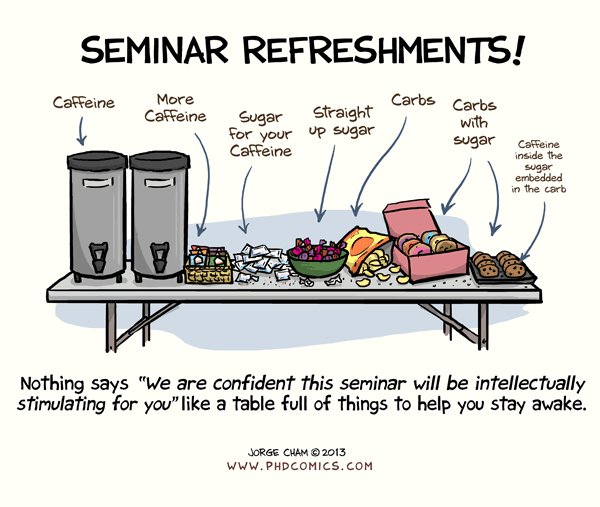 |
||
|
title:
"Seminar Food" - originally published
9/6/2013
For the latest news in PHD Comics, CLICK HERE! |
||
The NSA and cryptography: Cracked credibility
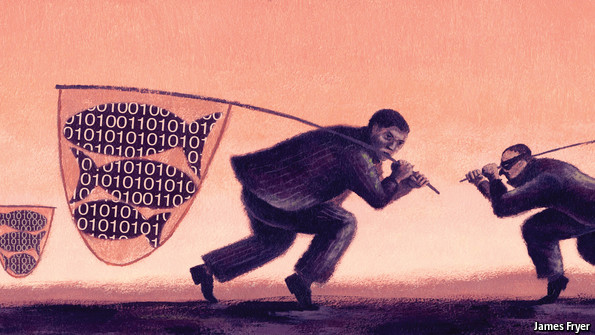
On jellyfish
Voracious, prodigiously reproductive, and potentially immortal. The future belongs to jellyfish… more»
#964; The Predictable Predicament
September 06, 2013
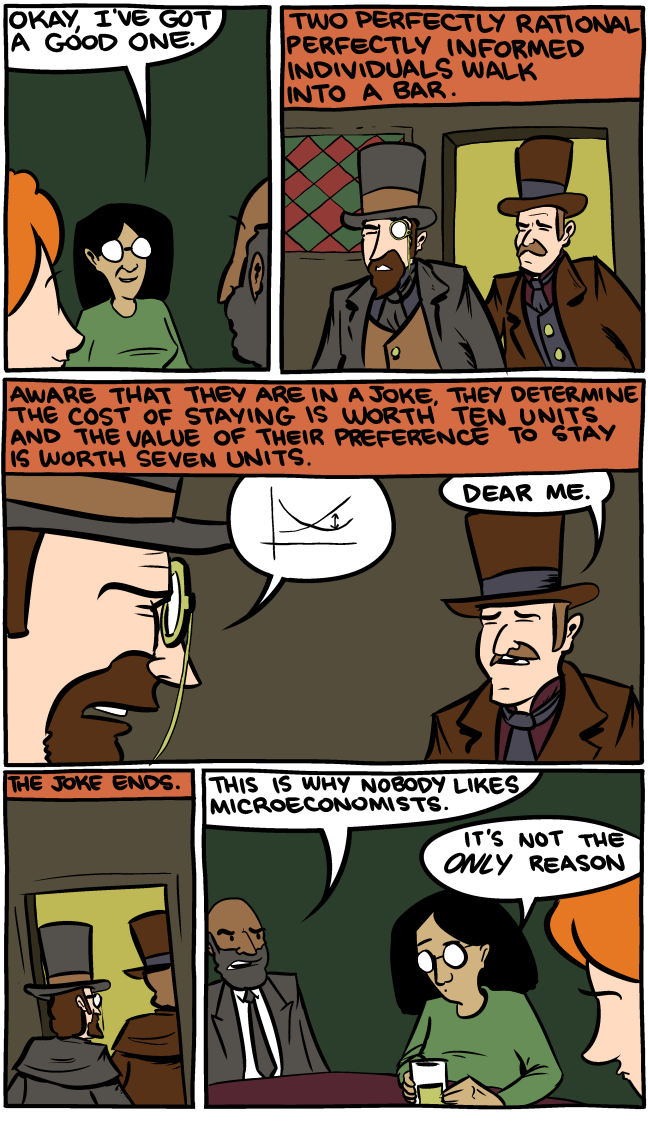
Hey Gaymers! My pals at GaymerX are having a sale until Monday (9/9). Items are already discounted, but if you have an order over $20 and you enter the code "smbc15" and you stand on one leg, you get 15% off.
buzzfeed: Living a comfortable middle class lifestyle is so...
Fervor
No opinion should be held with fervour. No one holds with fervour that seven times eight is fifty-six, because it can be known that this is the case. Fervour is only necessary in commending an opinion which is doubtful or demonstrably false.
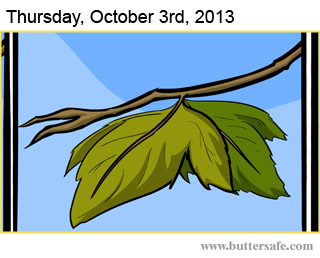























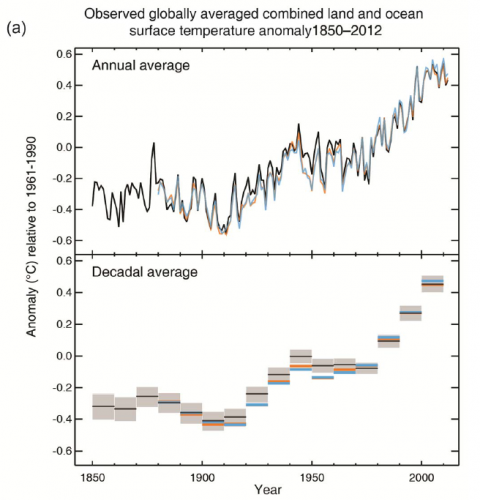
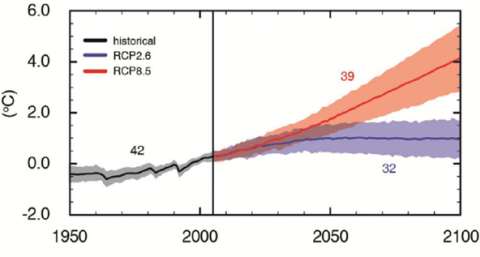

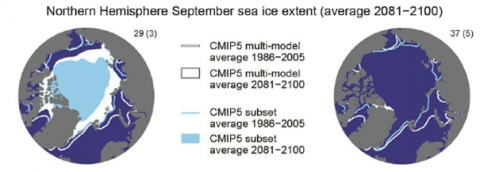
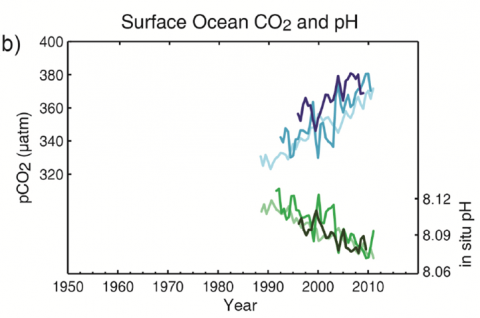




 Sometimes the landscapes we dream up in works of science fiction and fantasy are no match for the real thing. From unusual geological formations to rare and beautiful flora, these natural landscapes seem pulled from another world.
Sometimes the landscapes we dream up in works of science fiction and fantasy are no match for the real thing. From unusual geological formations to rare and beautiful flora, these natural landscapes seem pulled from another world.



